December 2025

The home healthcare market is projected to reach USD 517.81 billion by 2035, expanding from USD 226.92 billion in 2025, at an annual growth rate of 8.6% during the forecast period from 2026 to 2035.
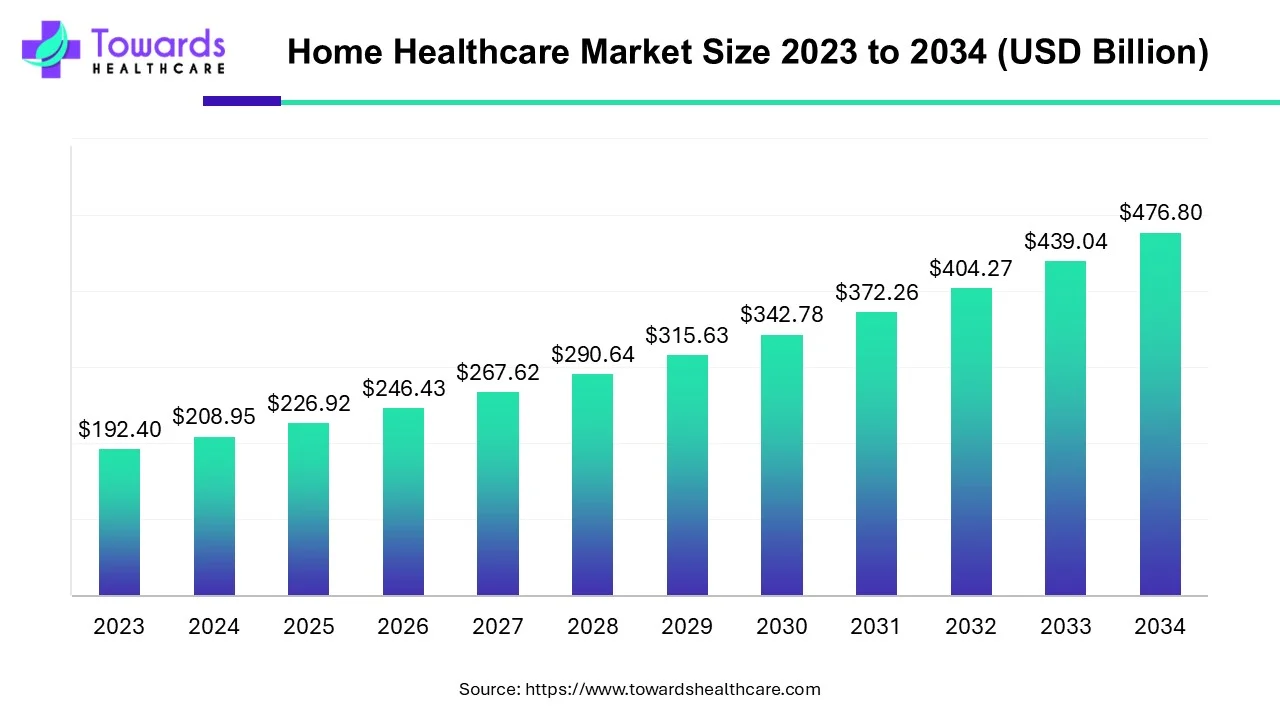
According to the International Diabetes Federation, around 536 million adults had diabetes in 2021, and this number is predicted to reach 783 million by 2045. Home healthcare services help individuals with diabetes manage their health at home, lowering the necessity for hospital visits and reducing overall care expenses.
| Metric | Details |
| Market Size in 2026 | USD 208.95 billion |
| Projected Market Size in 2035 | USD 517.81 Billion |
| CAGR (2026 - 2035) | 8.6% |
| Leading Region | North America |
| Market Segmentation | By Device Type, By Service, By Indication and By Geography |
| Top Key Players | GE HealthCare, Amedisys, LHC Group, BAYADA Home Health Care, Koninklijke Philips N.V., ResMed, Becton, Dickinson and Company |
Home healthcare is a service where healthcare professionals, like nurses and therapists, bring medical assistance and support directly to your home. This includes various services such as nursing care, physical therapy, and help with everyday activities like bathing or getting dressed. The critical concept is offering medical care for people who need it but would rather stay home than go to a hospital or clinic. This type of care is beneficial for different situations. It could be for people recovering from an illness, managing long-term health conditions, or individuals needing extra help. Home healthcare allows individuals to receive necessary medical attention while staying in a familiar and comfortable environment.
The home healthcare market has been growing for a few reasons. As the population ages, there is an increased demand for healthcare services. Older adults often prefer to age in place, and home healthcare supports that choice. Second, technological advancements and medical practices make it feasible to deliver complex healthcare services in a home setting. This includes using telemedicine for remote consultations and monitoring devices to keep track of health metrics. Additionally, the COVID-19 pandemic has accelerated the adoption of home healthcare. The desire to minimize exposure to crowded places has led more people to opt for home-based care. This has increased the demand for home healthcare services and prompted advancements in technology to make remote healthcare delivery more effective.
According to the CDC, about 12.1% of adults in the U.S. face difficulty walking or climbing stairs due to mobility-related disabilities. These disorders, affecting movement due to physical, psychological, or neurological issues, may be treated with physical therapy, assistive tools, and medications. Home healthcare services offer valuable support to individuals with mobility challenges, aiding with daily tasks to maintain independence. Physiotherapists in home healthcare help people regain mobility, functionality, and strength while reducing pain through exercises, movements, and massages. The increasing prevalence of mobility disorders drives the expected growth of this segment.
Home healthcare is a convenient and personalized way to receive necessary medical care in the comfort of one's home. The growing aging population, technological advancements, and the changing landscape of healthcare delivery have contributed to the increasing popularity and expansion of the home healthcare market.
Artificial intelligence (AI) is transforming home healthcare by enabling remote monitoring and providing personalized care plans. AI and machine learning (ML) algorithms can analyze vast amounts of data and help provide appropriate treatment regimens. They can streamline administrative tasks, improve patient safety, and enhance care quality. They minimize operational costs, reduce manual errors, and enable timely care. They can also send real-time data to healthcare professionals, allowing them to make effective proactive decisions.
For instance,
In January 2025, by securing $105 million, the Series C funding round, securing $105 million, had been closed by Geneoscopy Inc. Thus, the launch and commercialization of ColoSense, which is an at-home, stool-based colorectal cancer screening test of Geneoscopy, will be supported by this funding and help it to achieve new milestones.
In November 2024, an investment in General Prognostics Inc. (GPx), which is a rapidly growing MedTech startup revolutionizing chronic disease monitoring and management, was announced by NEC X.
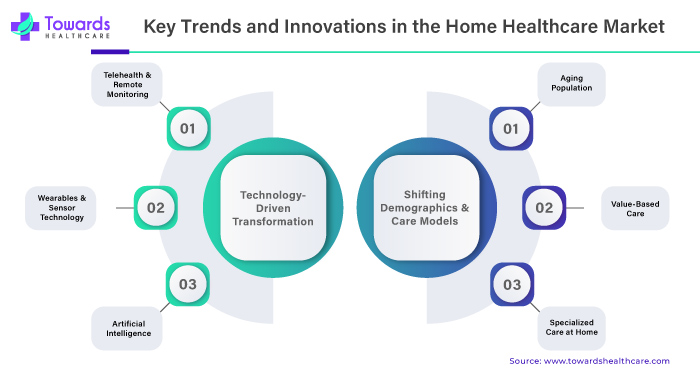
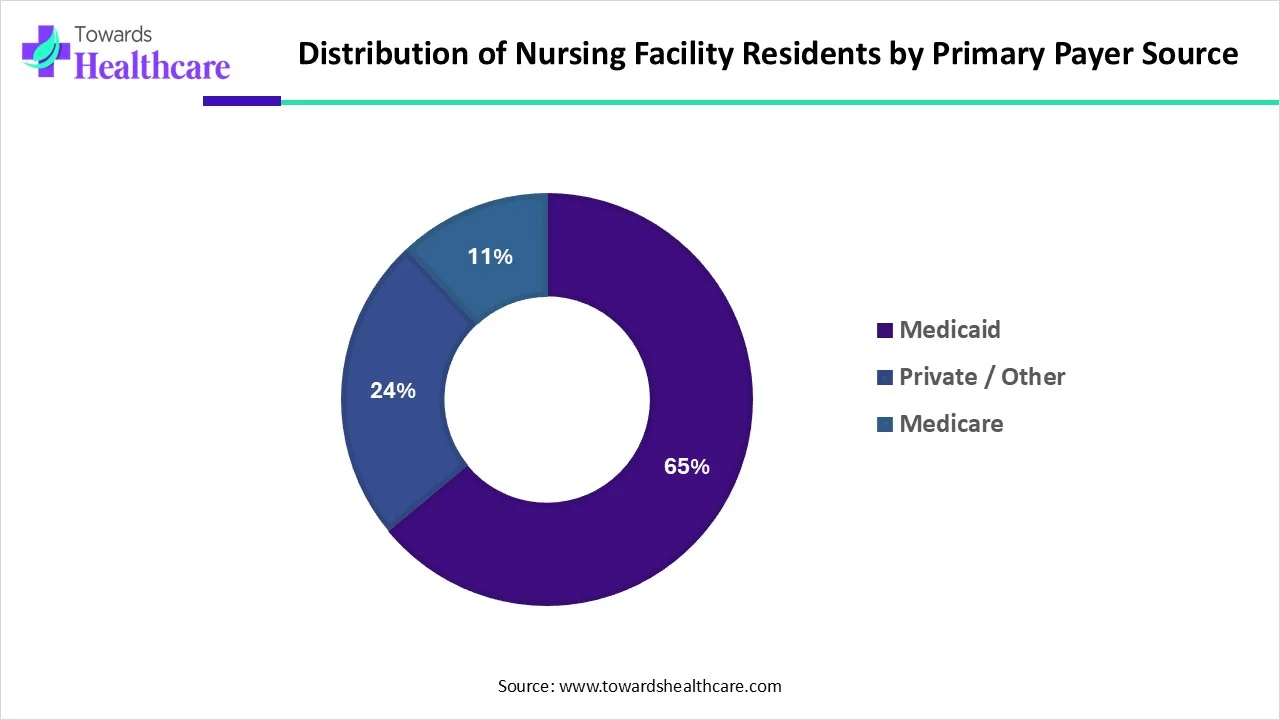
The data shows that Medicaid covers the majority of nursing facility residents in the United States. Out of the 1.2 million people living in certified nursing facilities, 63% rely on Medicaid as their primary payer. This means nearly three out of every five residents depend on Medicaid to cover long-term care costs, which reflects its crucial role in supporting older adults and individuals with disabilities who need continuous care.
Meanwhile, Private or other insurance sources cover 24% of residents. These residents either use personal funds, private long-term care insurance, or other non-government payers. This group represents about one-quarter of all residents, showing that a significant portion still pays out-of-pocket or through private plans.
Lastly, Medicare covers only 13% of nursing facility residents. Since Medicare primarily pays for short-term rehabilitation rather than long-term stays, only a small share of residents rely on it as their main payer. This percentage highlights Medicare’s limited role in ongoing nursing facility care.
Overall, the numbers clearly indicate that Medicaid remains the backbone of long-term nursing facility financing, while private pay and Medicare play smaller, more specific roles.
According to the 2023 National Diabetes Statistics Report by the CDC, in 2021, 38.4 million individuals, constituting 11.6% of the U.S. population, were diagnosed with diabetes. Among them, 38.1 million were adults aged 18 years or older, representing 14.7% of all U.S. adults. The age-specific breakdown indicates that 3.0% of those aged 18-44, 10.1% of individuals aged 45-64, and 28.7% of those aged 65 and older had diabetes. As the population continues to grow, the demand for home healthcare services is increasing due to the rising number of people with diabetes, emphasizing the need for suitable home constructions to cater to their healthcare needs.
The increasing demand for home healthcare services is strongly influenced by the aging population, characterized by a growing number of elderly individuals globally. This demographic shift has profound implications, driven by various factors that underscore the preference for receiving care in one's residence. As people age, they naturally tend to prefer healthcare services in the familiar and comfortable setting of their homes. This inclination stems from a desire to maintain independence and control daily life, even facing health challenges. The house serves as a place of emotional significance, offering established routines and a strong familiarity.
Additionally, home healthcare enables aging individuals to preserve their dignity and autonomy. By receiving necessary medical care in their living spaces, they can avoid the perceived loss of independence often associated with institutional settings. This is particularly crucial for those who aspire to age in place, continuing to reside in their homes for an extended duration. One of the key features of home healthcare is its emphasis on tailored and personalized care. Services are designed to meet the specific needs of each individual, addressing the unique health challenges and requirements that typically accompany the aging process. This customization ensures that care plans are adapted to individual preferences and medical conditions.
Notably, home healthcare plays a significant role in reducing the risk of institutionalization. By providing support at home, including medical assistance, rehabilitation, and help with daily activities, the functional abilities and overall well-being of aging individuals are enhanced. This, in turn, decreases the likelihood of them needing to move to long-term care facilities or nursing homes.
For instance,
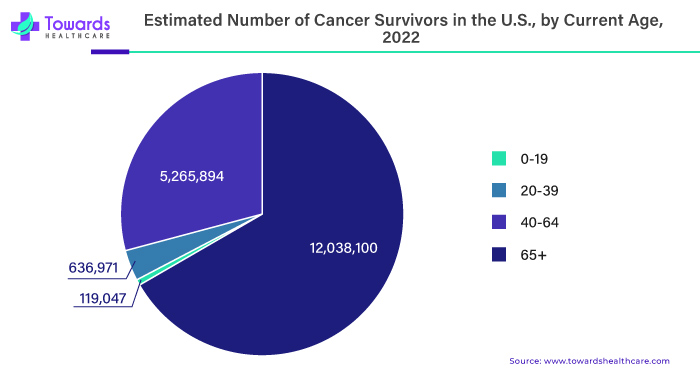
Furthermore, home healthcare promotes family and community integration. Many aging individuals have established social connections within their communities, and receiving care at Home allows for continued engagement with family and neighbors. This social aspect is essential for mental and emotional health, contributing to the overall aging experience.
The preference for home healthcare among the aging population is rooted in the desire for personalized, dignified, and autonomous care in a familiar environment. This aligns with the broader goal of aging in place and maintaining a higher quality of life for as long as possible. As the global population ages, the demand for home healthcare services is expected to persist and grow, influencing the future landscape of healthcare delivery.
Advancements in technology have revolutionized the landscape of home healthcare, ushering in a new era of possibilities for delivering advanced and comprehensive medical care within the familiar confines of one's Home. Notably, telehealth, a pivotal technological innovation, enables healthcare professionals to connect with patients remotely, facilitate virtual consultations, and monitor their health conditions. This not only enhances accessibility to healthcare services but also overcomes geographical barriers, ensuring that individuals in remote or underserved areas can receive timely medical attention.
Additionally, integrating remote monitoring devices further amplifies the capabilities of home healthcare. Wearable devices and sensors allow continuous tracking of vital signs, medication adherence, and overall health metrics. This real-time data empowers healthcare providers to monitor patients effectively, identify potential issues early on, and intervene promptly. Using such technology improves the efficiency of healthcare delivery and enhances the overall quality of care by enabling a more proactive and preventive approach. As technology advances, the home healthcare sector is poised to leverage these innovations for more personalized, efficient, and patient-centric care, shaping a future where complex medical care is seamlessly delivered in the comfort of one's home.
Patient and caregiver education is pivotal in successfully implementing home healthcare services. The effectiveness of home healthcare is not solely dependent on the availability of skilled healthcare professionals or advanced technologies but also on the informed and active participation of patients and their caregivers.
Education is crucial for creating awareness about the benefits of home healthcare. Many patients and their families may need to be fully aware of the scope of services offered at Home or the potential advantages, such as personalized care, comfort, and the ability to maintain independence. By providing clear and comprehensive information, healthcare providers can empower patients to make informed decisions about their healthcare options. Understanding the proper use of home healthcare services is equally important.
Patients and caregivers must be educated on navigating and making the most of available resources. This includes guidance on scheduling appointments, using telehealth platforms, and utilizing remote monitoring devices if applicable. Clear instructions on medication management, wound care, and other specific tasks ensure that patients receive the intended benefits of home healthcare without compromising safety or effectiveness.
Additionally, patient and caregiver education fosters active engagement in the care process. When individuals understand their health conditions, treatment plans, and the importance of adhering to prescribed interventions, they become more proactive in managing their health. This empowerment contributes to better treatment adherence, quicker recovery, and improved quality of life. The education process should be advanced to each patient's and their caregivers' specific needs and preferences. This may involve using various educational materials, such as written guides, videos, or interactive online resources.
Furthermore, regular communication between healthcare providers and patients is essential to address questions, provide updates, and ensure ongoing understanding and cooperation. In in-home healthcare, where a significant portion of care is often self-administered or provided by family members, caregiver education is paramount. Caregivers must have the knowledge and skills to offer proper assistance, monitor the patient's condition, and recognize signs that may require professional intervention.
Ultimately, patient and caregiver education contributes to the success of home healthcare and the overall patient experience. It fosters a collaborative and informed approach to healthcare delivery, aligning to promote patient-centered and personalized care in the home setting. As the home healthcare landscape continues to evolve, ongoing education efforts will be crucial to maximizing its potential and ensuring positive health outcomes for patients.
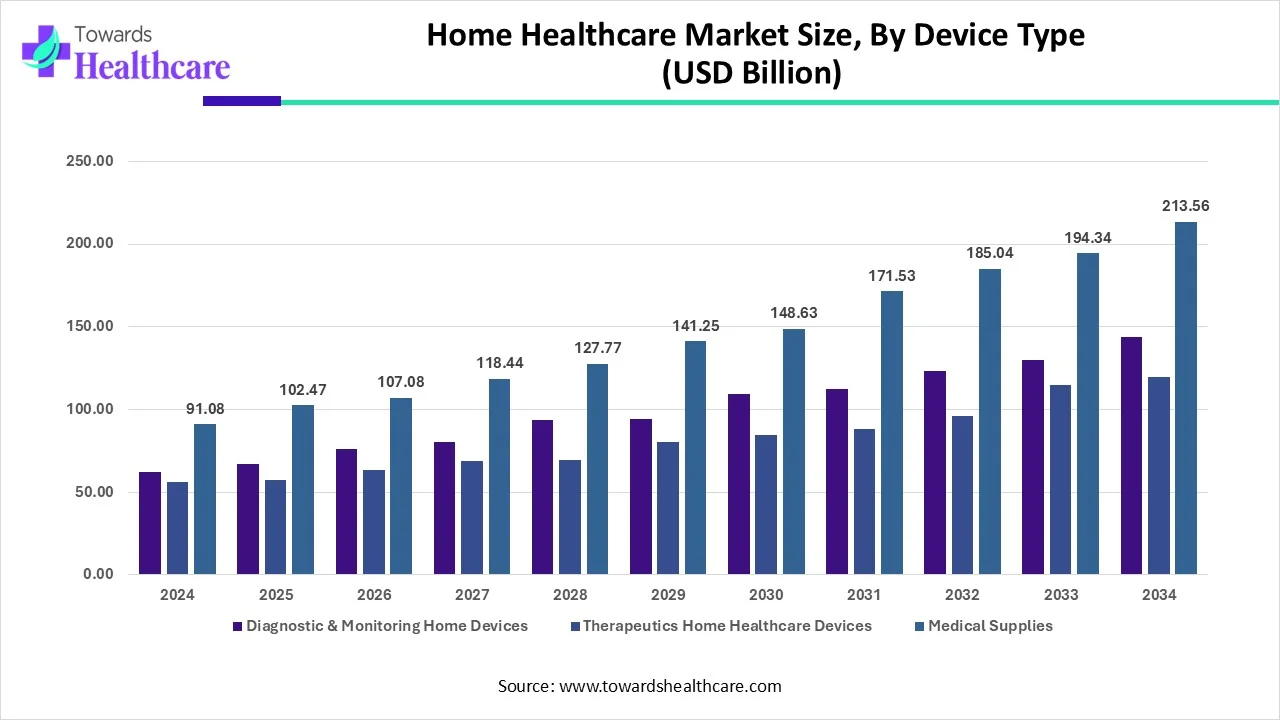
Home Healthcare Market Size, By Device Type (USD Billion)
| Year | Diagnostic & Monitoring Home Devices | Therapeutics Home Healthcare Devices | Medical Supplies |
| 2024 | 62.00 | 55.87 | 91.08 |
| 2025 | 67.17 | 57.28 | 102.47 |
| 2026 | 76.14 | 63.22 | 107.08 |
| 2027 | 80.48 | 68.70 | 118.44 |
| 2028 | 93.38 | 69.49 | 127.77 |
| 2029 | 94.28 | 80.10 | 141.25 |
| 2030 | 109.35 | 84.80 | 148.63 |
| 2031 | 112.45 | 88.29 | 171.53 |
| 2032 | 123.11 | 96.13 | 185.04 |
| 2033 | 130.01 | 114.70 | 194.34 |
| 2034 | 143.84 | 119.41 | 213.56 |
By device type, the diagnostics and monitoring home devices segment held the dominating share of 59% in the market in 2023. The use of diagnostic and monitoring home devices increased as there was a rise in the incidence rate of various chronic diseases. Moreover, their affordability and easy use increase their demand. They were also used after the surgeries for monitoring patients' conditions, which enhanced patient comfort and contributed to the market growth.
Home Healthcare Market Size, By Indication Type (USD Billion)
| Year | Cancer | Respiratory Diseases | Movement Disorders | Cardiovascular Diseases & Hypertension | Pregnancy | Wound Care | Diabetes | Hearing Disorders | Other |
| 2024 | 24.32 | 17.13 | 15.67 | 40.98 | 14.30 | 26.21 | 30.02 | 8.79 | 31.53 |
| 2025 | 25.63 | 25.24 | 16.15 | 41.23 | 9.04 | 32.22 | 33.41 | 12.15 | 31.84 |
| 2026 | 32.95 | 28.07 | 16.38 | 47.91 | 12.48 | 28.83 | 32.82 | 8.05 | 38.94 |
| 2027 | 30.77 | 24.48 | 24.55 | 47.63 | 10.45 | 29.84 | 39.36 | 17.14 | 43.39 |
| 2028 | 36.88 | 31.58 | 20.61 | 50.12 | 13.46 | 30.53 | 42.79 | 19.04 | 45.64 |
| 2029 | 40.23 | 33.00 | 25.27 | 57.48 | 15.49 | 32.22 | 46.11 | 12.49 | 53.35 |
| 2030 | 39.41 | 33.33 | 25.13 | 62.43 | 12.93 | 45.86 | 57.76 | 13.19 | 52.75 |
| 2031 | 42.49 | 37.83 | 32.99 | 69.83 | 23.19 | 40.78 | 54.00 | 20.77 | 50.39 |
| 2032 | 52.96 | 32.46 | 34.70 | 75.49 | 27.12 | 49.34 | 54.04 | 18.27 | 59.89 |
| 2033 | 48.55 | 43.25 | 33.40 | 76.81 | 19.96 | 58.81 | 64.33 | 29.15 | 64.80 |
| 2034 | 66.32 | 43.78 | 36.64 | 79.23 | 16.40 | 58.42 | 80.65 | 17.98 | 77.38 |
By indication type, the diabetes segment dominated the market with a 32% share in 2023. The use of home healthcare devices for monitoring the glucose level increased due to the rise in diabetes cases. The use of insulin delivery devices was also increased. Moreover, the growing awareness about the complications associated with diabetes has also enhanced their use.
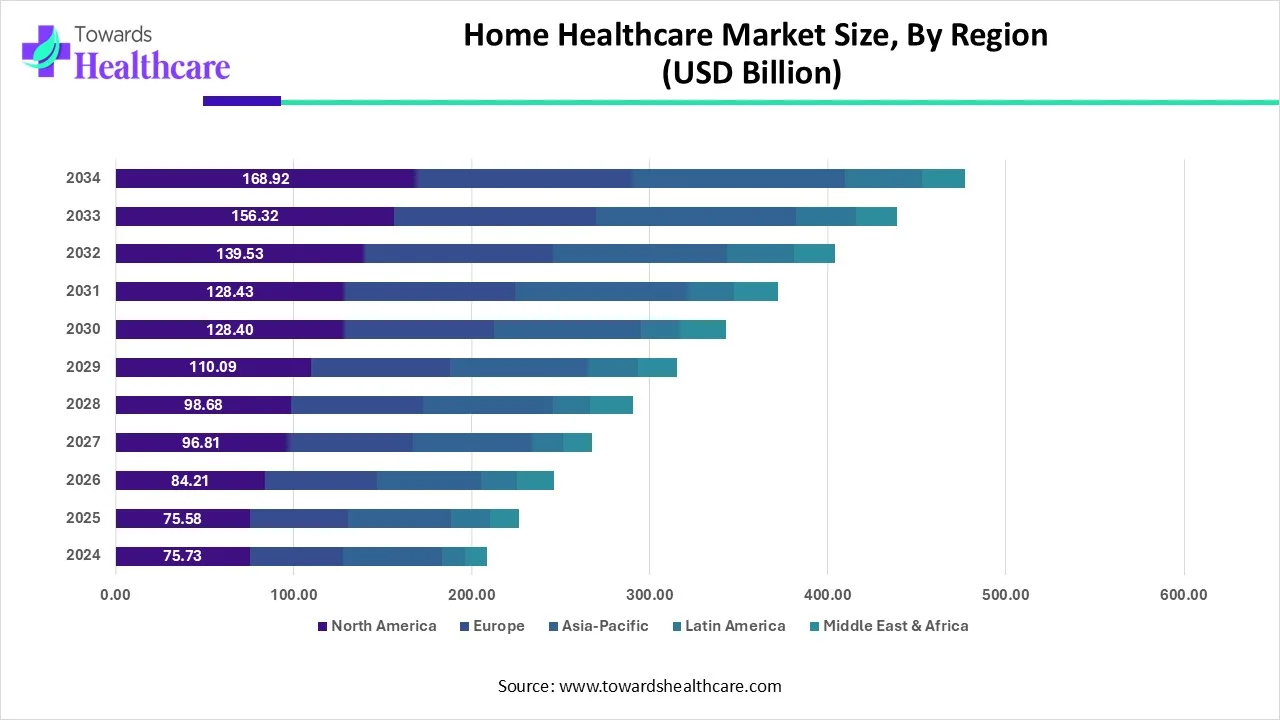
Home Healthcare Market Size, By Region (USD Billion)
| Year | North America | Europe | Asia-Pacific | Latin America | Middle East & Africa |
| 2024 | 75.73 | 52.03 | 55.77 | 13.07 | 12.36 |
| 2025 | 75.58 | 55.25 | 57.58 | 21.94 | 16.57 |
| 2026 | 84.21 | 63.01 | 58.21 | 20.38 | 20.62 |
| 2027 | 96.81 | 70.23 | 67.22 | 17.15 | 16.22 |
| 2028 | 98.68 | 73.86 | 73.12 | 20.99 | 23.99 |
| 2029 | 110.09 | 77.80 | 77.38 | 28.22 | 22.15 |
| 2030 | 128.40 | 84.49 | 82.22 | 21.88 | 25.80 |
| 2031 | 128.43 | 95.74 | 97.65 | 25.53 | 24.92 |
| 2032 | 139.53 | 106.23 | 97.95 | 37.20 | 23.37 |
| 2033 | 156.32 | 113.63 | 112.33 | 33.49 | 23.27 |
| 2034 | 168.92 | 121.46 | 119.55 | 42.98 | 23.89 |
The geographical landscape of home healthcare in North America reflects a diverse and dynamic distribution of services across different regions, shaped by demographic, economic, and healthcare infrastructure factors. The availability and proximity of healthcare facilities, including hospitals and clinics, can influence the prevalence of home healthcare. Regions with fewer healthcare facilities may rely more on home-based services. Cultural attitudes toward aging, healthcare, and family support can influence the acceptance and utilization of home healthcare services.
Cultural diversity across North America contributes to varied preferences in care. The geographical landscape of home healthcare in North America involves considering these multifaceted factors. The evolving nature of healthcare delivery, technological advancements, and demographic trends shifts continue to influence the distribution and accessibility of home healthcare services across the continent.
The geographical landscape of home healthcare in the Asia-Pacific region was characterized by a growing demand for home-based healthcare services due to factors such as an aging population, increasing prevalence of chronic diseases, and a focus on improving healthcare accessibility. Many countries in the Asia-Pacific region were experiencing demographic shifts with a rapidly aging population.
This demographic trend contributed to an increased demand for healthcare services, including home-based care, to address the unique needs of elderly individuals. Adopting technology in healthcare, including telehealth solutions, remote monitoring devices, and mobile health applications, played a significant role in shaping the home healthcare landscape. These technologies facilitated remote consultations, real-time health monitoring, and improved communication between healthcare providers and patients.
China Market Trends
China is experiencing growth in the home healthcare market due to increasing occurrences of diseases. The population affected by the diseases is increasing due to which results in a rise in the demand for diagnosis and effective management approaches. Hence, the use of home healthcare services increases. Furthermore, various technological advancements are also being adopted by the industries, which in turn are enhancing the new developments contributing to the market growth. At the same time, these developments are supported by the government, which improves the production process as well as makes the services affordable.
India Market Trends
Due to rising diseases, the use of healthcare services is increasing. At the same time, the growing healthcare sector is adopting various technological advancements, which in turn are enhancing the new development in home healthcare services. Furthermore, the early diagnosis and monitoring demanded by the population are also increasing due to rising awareness. Thus, to deal with the rising demand, the government is also providing investments for improved development and cost-effective services. Thus, all these factors are enhancing the market growth.
Europe is expected to grow significantly in the home healthcare market during the forecast period. The increasing awareness, as well as incidence of chronic diseases in Europe, is increasing the use of home healthcare devices. This, in turn, is driving their development and leading to new collaborations among the companies. At the same time, they are also utilizing advanced technologies to provide smart healthcare devices. Moreover, to increase their accessibility and affordability, investments from the government and private sectors are being provided. Thus, all these developments are promoting the market growth.
The competitive landscape of home healthcare is evolving with the participation of various players, including traditional healthcare providers, technology companies, and startups. Companies manufacturing medical devices and equipment used in home healthcare, such as home infusion pumps, respiratory devices, and monitoring devices, were key players. These companies often collaborated with healthcare providers to ensure the effective use of their devices in home settings. Pharmaceutical companies were involved in the home healthcare landscape by providing specialty medications, home infusion therapies, and patient support programs. These companies aimed to enhance medication adherence and provide comprehensive care for patients with chronic conditions.
In July 2025, after receiving FDA clearance for a wearable sensor that is a CardioTag device, which provides a non-invasive approach to monitor cardiac function, developed by Medical AI company Cardiosense, the company announced that it can capture seismocardiogram (SCG), high-fidelity electrocardiogram (ECG), and photoplethysmogram (PPG) signals simultaneously, making it the first multimodal, wearable sensor. Moreover, with the FDA clearance, the use of CardioTag for the non-invasive measurement of PPG, SCG, and ECG signals, along with pulse rate and heart rate, will be authorized.
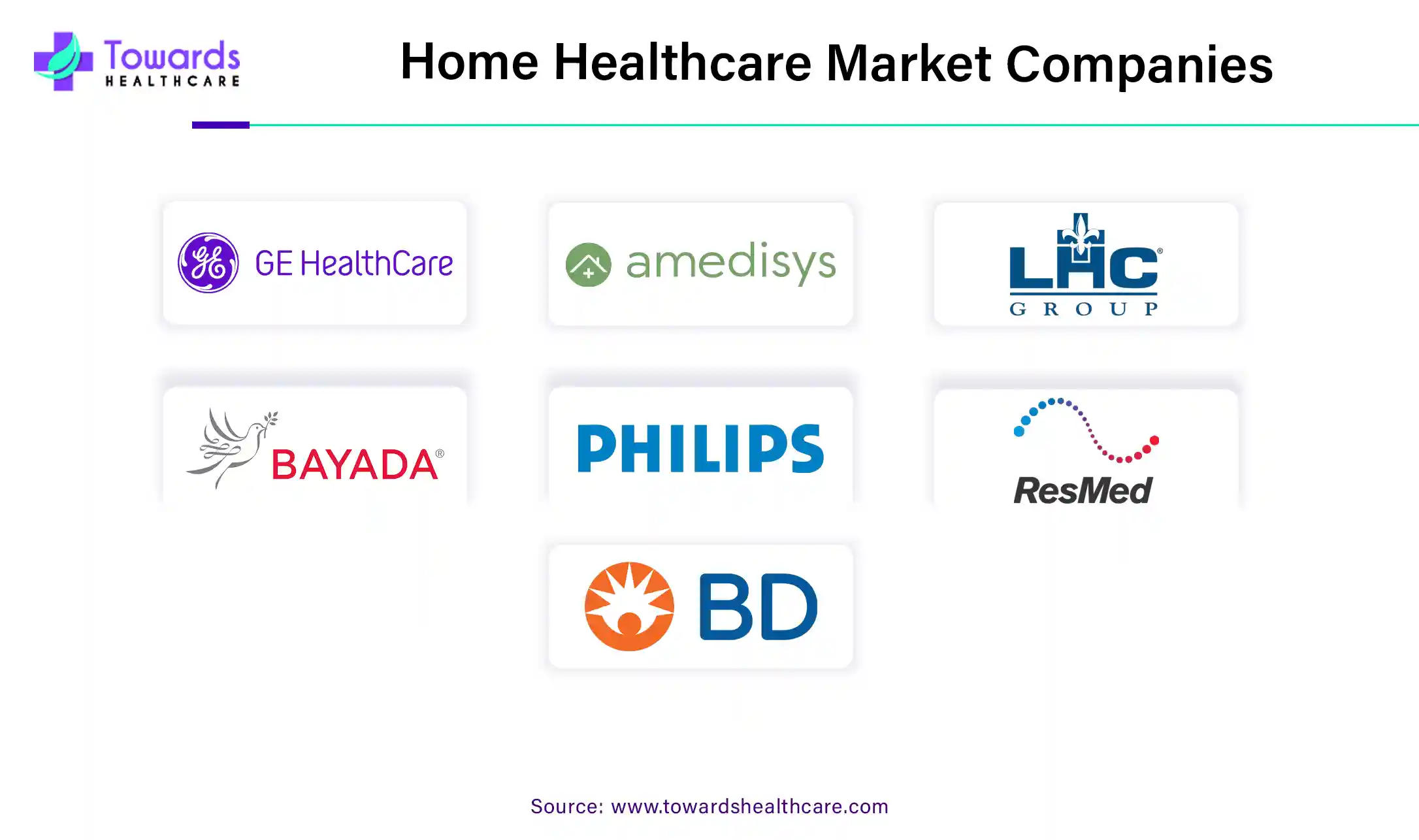
Read the company page and get to see how top players are transforming the Home Healthcare Market: https://www.towardshealthcare.com/insights/home-healthcare-market-size
By Device Type
By Service
By Indication
By Geography
December 2025
December 2025
December 2025
December 2025